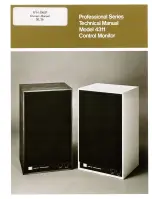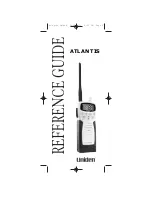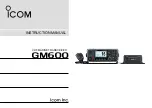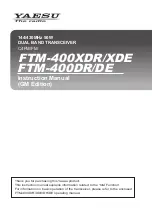
Page 13
Page 12
TYPICAL APPLICATIONS
The LT Series transceiver is ideal for the wireless transfer of serial data, control,
or command data. The transceiver does not perform any encoding or decoding
of the data, so the designer has a great deal of flexibility in the design of a
protocol for the system. The data source and destination can be any device that
uses asynchronous serial data, such as a PC or a microcontroller. If the
application is for remote control or command, then the easiest solution is to use
a remote control encoder and decoder. These ICs provide a number of data lines
that can be connected to switches or buttons or even a microcontroller. When a
line is taken high on the encoder, a corresponding line will go high on the
decoder as long as the address matches. The Linx MT Series transcoder is an
encoder and decoder in a single chip which allows bi-directional control and
confirmation using a transceiver. The figure below shows a circuit using the Linx
LICAL-TRC-MT transcoder.
This circuit uses the LT Series transceiver and the MT Series transcoder to
transmit and receive button presses. The MT Series has eight data lines, which
can be set as inputs and connected to buttons that will pull the line high when
pressed, or set as outputs to activate external circuitry. When not used, the lines
are pulled low by 100k
Ω
resistors. The transcoder will begin a transmission when
any of the input data lines are taken high. When a valid transmission is received,
the transcoder will activate the appropriate output data lines and then send a
confirmation back to the originating transcoder. When the confirmation is
received, the originating transcoder will activate its CONFIRM line. In this
example, this will turn on an LED for visual indication. The transcoder will
automatically control the power to the transceiver via the PDN line and the
transmit / receive state via the T/R SEL line.
The MT Series Transcoder Data Guide explains this circuit and the many
features of the transcoder in detail, so please refer to that document for more
information.
A 750
Ω
resistor is used on the LADJ line of the transceiver to reduce the output
power of the transmitter to meet North American certification requirements. This
value may need to be adjusted, depending on antenna efficiency and the power
allowed in the country of operation.
GND
VCC
GND
GND
750 ohm
100K
VCC
GND
GND
GND
100k
GND
VCC
VCC
D6
D7
CRT/LRN
ENC
S
EL
S
ER IO
CONFIRM
T/R PDN
T/R
S
EL
T/R DATA
D0
D1
D2
MODE IND
BAUD
S
EL
LATCH
D
3
D4
D5
GND
LICAL-TRC-MT
GND
200 ohm
GND
200 ohm
RF
1
GND
2
NC
3
R
SS
I
4
A REF
5
ANALOG
6
DATA
7
T/R
S
EL
8
PDN
9
GND
10
VCC
11
LADJ
12
TRM-XXX-LT
GND
VCC
VCC
GND
100k
VCC
GND
100k
VCC
BUZZER
GND
GND
GND
GND
200 ohm
GND
Figure 21: LT Transceiver and MT Transcoder
PROTOCOL GUIDELINES
While many RF solutions impose data formatting and balancing requirements,
Linx RF modules do not encode or packetize the signal content in any manner.
The received signal will be affected by such factors as noise, edge jitter, and
interference, but it is not purposefully manipulated or altered by the modules.
This gives the designer tremendous flexibility for protocol design and interface.
Despite this transparency and ease of use, it must be recognized that there are
distinct differences between a wired and a wireless environment. Issues such as
interference and contention must be understood and allowed for in the design
process. To learn more about protocol considerations, we suggest you read Linx
Application Note AN-00160.
Errors from interference or changing signal conditions can cause corruption of
the data packet, so it is generally wise to structure the data being sent into small
packets. This allows errors to be managed without affecting large amounts of
data. A simple checksum or CRC could be used for basic error detection. Once
an error is detected, the protocol designer may wish to simply discard the corrupt
data or implement a more sophisticated scheme to correct it.
INTERFERENCE CONSIDERATIONS
The RF spectrum is crowded and the potential for conflict with other unwanted
sources of RF is very real. While all RF products are at risk from interference, its
effects can be minimized by better understanding its characteristics.
Interference may come from internal or external sources. The first step is to
eliminate interference from noise sources on the board. This means paying
careful attention to layout, grounding, filtering, and bypassing in order to
eliminate all radiated and conducted interference paths. For many products, this
is straightforward; however, products containing components such as switching
power supplies, motors, crystals, and other potential sources of noise must be
approached with care. Comparing your own design with a Linx evaluation board
can help to determine if and at what level design-specific interference is present.
External interference can manifest itself in a variety of ways. Low-level
interference will produce noise and hashing on the output and reduce the link’s
overall range.
High-level interference is caused by nearby products sharing the same
frequency or from near-band high-power devices. It can even come from your
own products if more than one transmitter is active in the same area. It is
important to remember that only one transmitter at a time can occupy a
frequency, regardless of the coding of the transmitted signal. This type of
interference is less common than those mentioned previously, but in severe
cases it can prevent all useful function of the affected device.
Although technically it is not interference, multipath is also a factor to be
understood. Multipath is a term used to refer to the signal cancellation effects
that occur when RF waves arrive at the receiver in different phase relationships.
This effect is a particularly significant factor in interior environments where
objects provide many different signal reflection paths. Multipath cancellation
results in lowered signal levels at the receiver and, thus, shorter useful distances
for the link.































